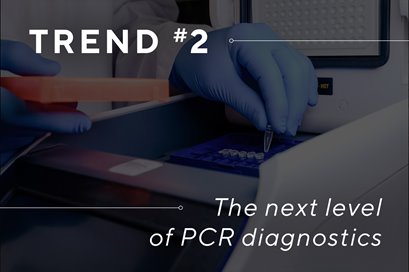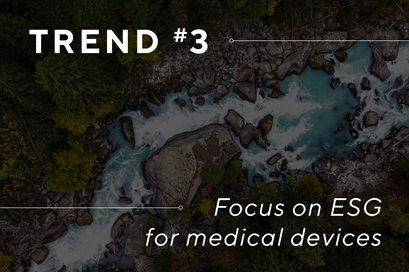As we look back on 2022, it’s plain to see a world still dealing with disruptions caused by the COVID-19 pandemic, while also adjusting to new macroeconomic challenges. Supply chain constraints and component shortages remained the talk of the industry, with medical device manufacturers facing elevated costs of logistics and procurement. We finished out the year operating in a new economic climate of high inflation, rising costs and rising interest rates, against the backdrop of increased geopolitical instability. Within this economic environment, we saw waves of layoffs within the tech industry, and the medtech industry wasn’t immune to this either.
As we look ahead at medical device industry trends for 2023, there’s a lot to consider. How might this environment affect the medical device industry? What can developers, creators and manufacturers of healthcare and life science technologies look forward to as we move into a new year? We asked our Healthcare and Life Sciences team to share some of the top medical device industry trends that we should be keeping an eye on.
Here are four medical device market trends we’re paying attention to.
Medical Device Trend #1: Building back supply chain resiliency
 Mike Tendick, VP, Healthcare and Life Sciences Market Sector
Mike Tendick, VP, Healthcare and Life Sciences Market Sector
It should come as no surprise that global supply chain challenges top the list. By the end of 2022, it seems even our kids were using the phrase “supply chain issues” in casual conversation. Supply chain went mainstream as nearly every aspect of the economy felt the effects of shortages. But, while a delay in the delivery of your new smartphone may lead to disappointment, or a child not getting their new gaming system on time might even cause some tears, supply chain shortages that leave hospitals without critical medical equipment can be a matter of life or death.
That’s why healthcare and life sciences companies are more focused than ever on the resiliency of their supply chain. A few trends and strategies for building supply chain resiliency are worth highlighting:
- Multi-sourcing at the component level. While single-sourcing components can reduce complexity, recent history has shown just how risky this can be during times of disruption. Medical device manufacturers are looking to multi-source components as much as possible. This path isn’t without its challenges. Some parts are core to the system, such as a digital signal processor (DSP) or a specific microprocessor. It can be unrealistic to multi-source these components—changing to a new DSP or microprocessor will almost certainly mean some level of redesign, likely requiring resubmission for FDA approval. One way to help address this challenge is by building relationships with those part suppliers who are absolutely critical, and establishing an escalation contact you can turn to for help if an issue does occur.
- Reshoring and nearshoring. Device manufacturers are looking deeper into the supply chain to understand where their parts are coming from. More wafer fabrication factories are being built outside of the Asia Pacific region where they’ve generally been concentrated. If your parts are coming from nearer and/or more stable areas, supply chain risk can be reduced.
- Design for Supply Chain. Closely tied to the previous point, manufacturers should begin the process of determining where parts will be coming from as early as possible. Consider how, when and from where you’re sourcing components as you are designing them into the product. This allows medical device manufacturers to make design choices that will help mitigate supply chain risks further down the road.
This need for supply chain resiliency hasn’t escaped the notice of government bodies, either. The FDA has created a new initiative, the Resilient Supply Chain Program (RSCP), to help address the issue. The mission of the RSCP program is “to strengthen public health supply chains and promote availability of medical devices by proactively monitoring, assessing, and communicating risks and vulnerabilities.” Among other things, the program is intended to help:
- Mitigate disruptions and shortages in the medical device supply chain
- Enhance supply chain visibility
- In the event of supply chain interruptions, collaborate with government partners and medical device stakeholders to triage and address the issues.
In this environment, proactive supply chain solutions will continue to be a top priority for medical device manufacturers. Thinking about supply chain from the earliest moments and relying on the relationships of a dependable, global supply chain partner will be critical to building back supply chain resiliency.
Medical Device Trend #2: Taking PCR diagnostic testing to the next level
 Jenna Joestgen, Director of Engineering Solutions
Jenna Joestgen, Director of Engineering Solutions
In 2022, we saw that the COVID-19 pandemic pushed life science instrument development into newer territories, faster. Two life sciences technology trends came out of this—an acceleration of and a progression beyond standard point-of-care diagnostic instrument development—both of which are still a factor heading into 2023. Life sciences companies are asking, “How can we get more types of testing and results out to where they’ll be needed most?” And, “How can we do it faster?”
The pandemic put massive pressure on manufacturers of point-of-care testing devices to increase production and to accelerate the entire product development process. That’s the kind of pressure cooker where innovations often become new standards. Those innovations are now fueling what’s next for life science instrumentation.
And what is next? The push to make more tests available, in more user-friendly forms, delivered to the point of use faster. Innovations aiming to get highly sophisticated analyzers and PCR-level testing directly into the hands of consumers. Greater demand for personalization in patient care, driving further innovation in genomics and molecular diagnostics.
By embracing the possibilities of recent advances in instrument development—including digital transformation, machine learning and automation—forward-thinking life science companies can continue to lead the way toward better care, greater access and more personalized treatment.
To capitalize on these opportunities, life science companies will need partners who understand the time-to-market pressure, complexities and requirements of today’s diagnostic instrument development landscape. They’ll need partners ready to jump in and innovate along with them—plugging in how, where and when they’re needed—complementing the OEM’s own team with the resources and expertise they don’t, or perhaps couldn’t, have in-house. And they’ll need partners who bring the right tools to the table—like a highly skilled User-Centered Design team—to make life science instruments more accessible for everyday (read: not PhD-level) users of these new technologies.
Medical Device Trend #3: Increasing focus on ESG
 Megan Schleicher, Senior Director of ESG
Megan Schleicher, Senior Director of ESG
Environmental, social and governance (ESG) continues to build steam across industries. So it’s no surprise that ESG is one of our key medical device industry trends for 2023 and beyond. Investors, customers and the general public are holding corporations to higher ethical, social and environmental standards, and medtech is no exception.
For the medical device industry, all three areas of ESG will be critical to focus on:
Environmental
The sustainability of medical devices has become a hot topic, especially when it comes to single-use or limited-use devices. According to IEEE, “about 5 million tons of health care waste ends up in landfills each year.”
How can we meet the mandate of patient safety while also reducing the waste that results from single-use instruments? How might we manufacture and deliver medical devices in a more environmentally sustainable way?
Medical device manufacturers need to be considering sustainability throughout the product lifecycle, starting from the earliest design phases. That means employing design for sustainability, selecting more sustainable materials and establishing production processes that reduce waste and lower emissions.
Product lifecycle extension adds another piece to the puzzle—designing medical devices to be simple to repair, update or reprocess. Keeping medical devices and their components in the market longer is an important part of shifting toward a circular healthcare economy.
Social
Health equity and access to healthcare services are critical to building a more equitable world, and manufacturers of medical devices and life science instruments can play a lead role. That can look like expanding access through simple and powerful point-of-care testing devices that bring advanced diagnostic capabilities directly to patients, wherever they happen to be. It could be therapeutic devices that bring the hospital into the home. It might look like real-time gathering of patient data and sophisticated analysis to create personalized treatment plans that are tailored to the individual’s unique needs.
A key part of making medical technology more accessible is focusing on designing a user experience that is simple and intuitive—otherwise the technology itself can become a barrier to equity. Medical device manufacturers can prioritize equity, access and inclusivity by taking a user-centered design approach to product development.
Governance
We mentioned the levels of personalization that patient data gathering can unlock. Advances in AI and machine learning will only increase these possibilities. But, just as AI drives greater personalization in healthcare, it can also raise questions of security and ethics.
The key consideration when gathering and transmitting huge amounts of patient data is how to keep that data safe. This is nothing new—but new threats to data security emerge every day. Medical device cybersecurity is more important now than ever (more on this in a bit).
Then there are the ethical questions. There’s enormous value in the ability of AI to help healthcare providers and patients make better decisions about care. The benefits are clear—but the ethical implications can be complex. Yale School of Medicine boils it down to two areas: “the potential loss of physician autonomy and the unconscious amplification of underlying biases.” In short:
- If AI is making the decisions, does liability shift from doctors to the manufacturers of AI-enabled devices?
- If there’s bias in the dataset that trains the AI, that bias will be reflected or even amplified in practice.
There’s no easy answer for many of these questions. As technology advances, medical device manufacturers will need to be increasingly aware of and proactive about the ethical aspects of the products they’re introducing to the world.
Medical Device Trend #4: Accelerating advances with AI and machine learning
 Jenna Joestgen, Director of Engineering Solutions
Jenna Joestgen, Director of Engineering Solutions
You can’t go too far today without tripping over a new AI-powered innovation. AI has recently burst into the mainstream consciousness in a big way, thanks to powerful new platforms like ChatGPT or DALL-E. The possibilities presented by AI seem to be endless—and the same can be said when it comes to the medical device industry.
According to a report by Grand View Research, the market size for AI in healthcare is expected to grow from $15.4 billion in 2022 to $208.2 billion by 2030. A significant driver of the expansion belongs to medical technologies like diagnostics and robotic-assisted surgery. There’s great opportunity for those companies that are able to figure out effective ways to integrate machine learning algorithms and advanced AI capabilities into their existing or upcoming portfolio of healthcare and life sciences products.
Even if you’re not looking to integrate AI into current products, you’ll want to pay attention to this medical device trend. On the product development and production side, machine learning algorithms allow manufacturers to analyze data and implement a more accurate solution, at an increased velocity, which unlocks new possibilities for improving both products and processes. And fortune favors the prepared. The better a manufacturer is prepared to jump in when the time is right—including understanding evolving regulations—the better they’ll be positioned for success in an increasingly digital landscape.
We’ve also mentioned personalization a few times, and that’s where these technologies really position the industry for growth. AI and machine learning have the power to improve medical decision-making, aid in planning of procedures and unlock entirely new levels of personalized treatment. Combine this with the increasing capabilities of 3D printing and the possibilities for individualization of healthcare become nearly limitless.
Of course, as technology becomes smarter and more connected, cybersecurity for medical devices becomes that much more critical. And there are two sides to the issue of cybersecurity to consider. First, the product development and manufacturing side—how a partner controls and protects the customer’s information. Then there’s the security of connected products against cyber threats when they’re in use out in the market. Healthcare OEMs will need to make sure that they’re working with partners who not only understand, but are proactively prepared for the cybersecurity needs of today’s medical device industry.
It’s worth noting that it’s not only new, more advanced equipment that’s at risk. Cybersecurity can be an even bigger challenge for legacy products already in the field. Every medical device that can be accessed digitally needs to make security a priority. Because it’s not just about protecting data—in the end we’re protecting the people whose lives depend on the devices we make.
Are you prepared for these medical device industry trends?
There’s plenty to look forward to in the healthcare and life sciences market. Yes, there will be more challenges to navigate. But there’s opportunity on the horizon.
No matter the medical device trends you’re most focused on, one key to success will be to build strong partnerships to help prepare for them. Smart outsourcing—whether it’s in the early design and development phases, manufacturing, or service and support after your products hit the market—can add the expertise, capabilities and capacity to move faster and enter the market more competitively.
If you’re not sure what that kind of partnership could look like, reach out to the Plexus team. We have decades of experience helping market leaders design, manufacture and sustain complex healthcare and life science products. We can help you determine the best way forward to bring your innovation to the customers—and the patients—who are counting on what you’ll create.